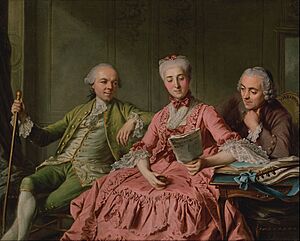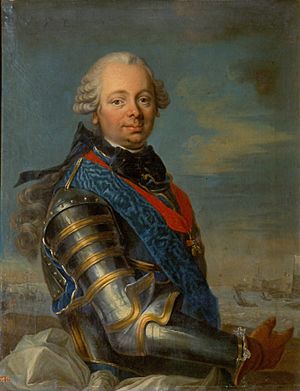Étienne François de Choiseul, Duke of Choiseul facts for kids
Quick facts for kids
The Most High and Most Potent Lord
Étienne François de Choiseul
Marquis of Stainville, Duke of Choiseul
|
|
|---|---|

Étienne François de Choiseul. Painting by Louis-Michel van Loo.
|
|
| First Minister of State | |
| In office 3 December 1758 – 24 December 1770 |
|
| Monarch | Louis XV |
| Preceded by | André-Hercule de Fleury (1743) |
| Succeeded by | René Nicolas Charles Augustin de Maupeou |
| Minister for Foreign Affairs | |
| In office 3 December 1758 – 13 October 1761 |
|
| Monarch | Louis XV |
| Preceded by | François-Joachim de Pierre de Bernis |
| Succeeded by | César Gabriel de Choiseul |
| In office 10 April 1766 – 24 December 1770 |
|
| Monarch | Louis XV |
| Preceded by | César Gabriel de Choiseul |
| Succeeded by | Louis Phélypeaux |
| Minister of War | |
| In office 27 January 1761 – 24 December 1770 |
|
| Monarch | Louis XV |
| Preceded by | Charles Louis Auguste Fouquet |
| Succeeded by | Louis Phélypeaux |
| Ambassador of the Kingdom of France to the Archduchy of Austria | |
| In office 1757 – 1758 |
|
| Monarch | Louis XV |
| Preceded by | Louis Charles César Le Tellier |
| Succeeded by | César Gabriel de Choiseul |
| Personal details | |
| Born | 28 June 1719 Nancy, Duchy of Lorraine |
| Died | 8 May 1785 (aged 65) Paris, Isle-de-France, Kingdom of France |
| Residences | Château de Chanteloup, Touraine |
| Awards | |
| Signature | |
| Military service | |
| Allegiance | |
| Branch/service | |
| Years of service | 1740 – 1770 |
| Rank | Lieutenant General |
| Battles/wars | Russo-Turkish War War of the Austrian Succession Seven Years' War |
Étienne François de Choiseul (born June 28, 1719 – died May 8, 1785) was an important French military officer, diplomat, and statesman. He held the titles of Marquis of Stainville and Duke of Choiseul. He was also a Knight of the Order of the Holy Spirit and the Order of the Golden Fleece.
From 1758 to 1761, and again from 1766 to 1770, he served as France's Foreign Minister. He had a major impact on France's plans around the world during this time. He is known for France's defeat in the Seven Years' War and his efforts to make France strong again afterward.
Contents
Étienne François de Choiseul: Early Life and Career
Becoming a Leader: Choiseul's Rise to Power
Étienne François was born in Nancy, a city in the Duchy of Lorraine. His father was a key advisor to the Duke of Lorraine. At birth, Étienne François was known as the comte de Stainville.
In 1737, the ruler of Lorraine, Francis Stephen, had to give up his duchy. He became the ruler of Tuscany in Italy instead. Étienne François realized that staying loyal to Lorraine would limit his chances. So, he decided to serve France.
Military Service and Early Successes
After gaining experience in the Austro-Turkish War, Choiseul joined the French army. He fought in the War of the Austrian Succession. He showed bravery in Bohemia in 1741 and Italy in 1744. He was especially noted at the Battle of Coni.
He also saw the French defeat at the Battle of Dettingen in Germany. He was shocked by the French army's "indifference and ignorance" there. This experience later inspired him to reform the French military.
From 1745 to 1748, he served with the army in the Low Countries. He was present at important sieges like Mons and Charleroi. He reached the rank of lieutenant-general. In 1750, he married Louise Honorine Crozat. She brought a large fortune to their marriage and was a very supportive wife.

Choiseul gained the support of Madame de Pompadour, a powerful friend of King Louis XV. In 1753, he became ambassador to Rome. There, he handled talks about problems caused by a papal order called Unigenitus. He did well in this job.
In 1757, Madame de Pompadour helped him move to Vienna. His task there was to strengthen the new alliance between France and Austria. He helped write the Second Treaty of Versailles in May 1757. This treaty committed France and Austria to fight together against Prussia in Germany.
Choiseul as Chief Minister of France
Leading France During the Seven Years' War
His success in Vienna led to a bigger role in 1758. He replaced Cardinal de Bernis as minister for foreign affairs. This meant he was largely in charge of France's foreign and military plans during the Seven Years' War.
In 1759, he planned a big invasion of Britain. However, French naval defeats at the Battle of Lagos and Battle of Quiberon Bay stopped this plan. Another major plan to win in 1759 was an attack on Hanover. This was also stopped by the French defeat at the Battle of Minden. Between 1759 and 1762, other French efforts in Germany were not successful.
Choiseul was then made a peer of France and given the title duc de Choiseul. From 1761 to 1766, his cousin César Gabriel de Choiseul was foreign minister. But Choiseul still controlled France's policies until 1770. He also held many other important government jobs.
He created the Pacte de Famille, an alliance with the Spanish House of Bourbon. He hoped this would help fix the bad results of the alliance with Austria. But it was too late to change the outcome of the war. However, his strong actions in other government areas were helpful.
He came to power when France was feeling down after defeats like Rossbach. With courage and energy, he improved and strengthened both the army and navy. Even though it was too late to save Canada and India, he helped develop French colonies in the Antilles and San Domingo.
He also managed affairs within France well. He allowed the Encyclopédie to be published. He also helped banish the Jesuits and temporarily abolish their order.
Rebuilding France's Power After the War
After the Treaty of Paris (1763) in 1763, Choiseul worked to rebuild the French military. He was worried about Britain's victory in the Seven Years' War. He tried to keep Spain's support for a future war against Britain. He also made plans to invade Britain.
To make up for France's lost lands, he added Corsica and Lorraine to France. He led the French conquest of Corsica. He also oversaw a plan to settle Guiana, which did not succeed. By the late 1760s, Choiseul was concerned about Russia's growing power. He feared Britain was supporting Russia. He thought they were planning a "northern league" against France. To stop this, he encouraged the Ottoman Empire to attack Russia.
However, Choiseul's power began to fall. This was due to his actions against the Jesuits and his support for their opponents. After Madame de Pompadour died in 1764, his enemies became stronger. These enemies included the king's new friend, Madame du Barry, and the chancellor Maupeou.
Choiseul had supported his sister in trying to become the king's friend. This put him against Madame du Barry. To strengthen the alliance with Austria, Choiseul supported the marriage of the Dauphin, who would become Louis XVI, to Marie Antoinette. She was a daughter of the Holy Roman Empress Maria Theresa. Choiseul saw this marriage as a big success for himself. He believed it would secure his position of power.
In 1770, a disagreement between Britain and Spain over the Falkland Islands almost led to war. Choiseul strongly supported Spain. He prepared the French military for war. But King Louis XV wanted peace after many wars during his reign. He was angry when he found out about Choiseul's actions. At the peak of this crisis in 1770, Choiseul was dismissed. He was ordered to retire to his country estate, the Château de Chanteloup. The crisis was then resolved peacefully by Britain and Spain.
Retirement and Final Years

Even though he was removed from power, Choiseul became even more popular. During his retirement, which lasted until 1774, he lived very comfortably. Many important people visited him.
He was replaced as Chief Minister by Emmanuel-Armand de Richelieu, duc d'Aiguillon. D'Aiguillon's foreign policy was similar to Choiseul's. However, d'Aiguillon favored a stronger monarchy. He was also closely linked to Madame Du Barry's group. Choiseul was very popular, and many people came to say goodbye as he left Paris for his estate.
To Choiseul's disappointment, Louis XVI did not give him back his old job. However, the king allowed him to return to Paris in 1774. Choiseul died in Paris on May 8, 1785. He was buried in Chanteloup. He left behind many debts, which his widow carefully paid off. Choiseul's widow lived quietly until her death in 1801.
Choiseul's Legacy and Character
Choiseul was a talented and hardworking person. He had good ideas and was open-minded in how he managed things. He was described as a short man with a strong build. His Mémoires (memories) were written during his time in exile. They are notes on different topics.
The English writer Horace Walpole described Choiseul as someone who would plan big changes for a country. He also said that Choiseul spent a lot of money, both his own and the country's.
Art Collection and Patronage
Choiseul loved music, theater, and art. He built one of the most important art collections in France. He was a generous supporter of many French artists. We know a lot about his collection from two important records. One is a snuffbox with five tiny paintings from 1770–1771. These paintings show the inside of his Paris home. The other is a 1771 catalog of his collection with engravings.
Choiseul's art collection mainly had Dutch, Flemish, and French paintings. It included eight works by Rembrandt. It also had famous pieces like Jacob van Ruisdael's Shore at Egmond aan Zee and Gerard ter Borch's Woman Playing a Theorbo to Two Men.
He also owned many engraved pictures of France. He had one of the most famous pieces of French furniture from the 18th century. This was a desk later owned by important figures like Talleyrand.
Images for kids
See also
 In Spanish: Étienne François de Choiseul para niños
In Spanish: Étienne François de Choiseul para niños


